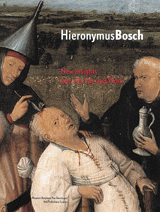
Van Dijck 2001b
“Hieronymus van Aken / Hieronymus Bosch: His Life and ‘Portraits’” (G.C.M. van Dijck) 2001
[in: Jos Koldeweij, Bernard Vermet and Barbera van Kooij (eds.), Hieronymus Bosch. New Insights Into His Life and Work. Museum Boijmans Van Beuningen – NAi Publishers – Ludion, Rotterdam, 2001, pp. 8-16]
In this contribution to the scientific catalogue of the Bosch exhibition in Rotterdam (2001) Lucas van Dijck summarizes two chapters from his book that was published more or less at the same time [see also Van Dijck 2001a]. Van Dijck surveys the most important results of his lengthy archival research of the Bossche Schepenakten (Deeds of the Aldermen of ’s-Hertogenbosch) and of the accounts of the Confraternity of Our Lady. He also briefly addresses the question whether any (self-)portraits of Bosch have been preserved.
When dealing with Bosch’s biography Van Dijck emphasizes the following matters.
Bosch and his wife Aleid van de Meervenne were probably born around 1450 (perhaps Aleid was somewhat older than her husband) [pp. 10-11]. When he was about twelve, Bosch’s family moved to the Market Square [p. 9]. He came from a family of painters and probably got his training in the family workshop of his father [p. 9]. Jheronimus was a lower cleric (only clerics could become sworn members of the Confraternity of Our Lady), so he probably attended the Latin school in ’s-Hertogenbosch [p. 9]. His father Anthonius died in 1478, when Jheronimus was about 28 years old [p. 10].
Jheronimus’ mother was a natural child and in his wife’s family there were also a number of natural children. In those days this was not considered as something to be ashamed of [p. 12]. Aleid’s only brother, Godefridus van de Meervenne, had studied at a university but died young in 1484 [p. 13]. After their marriage Jheronimus and Aleid lived in a house at the Market Square, In den Salvatoer (In the Redemptor), which Aleid had inherited [pp. 12-13]. Their marriage was childless [p. 13]. Jheronimus died in August 1516, probably because of an epidemic in ’s-Hertogenbosch [p. 14].
Bosch’s portrait has probably been preserved in a drawing from the Recueil d’Arras (dating from around 1560). A sixteenth-century print and a painting are probably based on this drawing. Van Dijck points out supposed self-portraits of Bosch in the Crowning with Thorns (Escorial) and in the Adoration of the Magi (Philadelphia). In those supposed self-portraits Bosch seems to be almost a generation younger than in the drawing, which shows a man of about sixty years old.
[explicit]